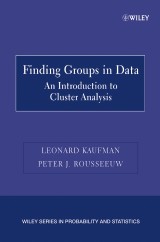Details

Finding Groups in Data
An Introduction to Cluster AnalysisWiley Series in Probability and Statistics, Band 344 99. Aufl.
|
123,99 € |
|
| Verlag: | Wiley |
| Format: | |
| Veröffentl.: | 25.09.2009 |
| ISBN/EAN: | 9780470317488 |
| Sprache: | englisch |
| Anzahl Seiten: | 368 |
DRM-geschütztes eBook, Sie benötigen z.B. Adobe Digital Editions und eine Adobe ID zum Lesen.
Beschreibungen
<p>The <b>Wiley-Interscience Paperback Series</b> consists of selected books that have been made more accessible to consumers in an effort to increase global appeal and general circulation. With these new unabridged softcover volumes, Wiley hopes to extend the lives of these works by making them available to future generations of statisticians, mathematicians, and scientists.</p> <p>"Cluster analysis is the increasingly important and practical subject of finding groupings in data. The authors set out to write a book for the user who does not necessarily have an extensive background in mathematics. They succeed very well."<br />—<i><b>Mathematical Reviews</b></i></p> <p>"Finding Groups in Data [is] a clear, readable, and interesting presentation of a small number of clustering methods. In addition, the book introduced some interesting innovations of applied value to clustering literature."<br />—<i><b>Journal of Classification</b></i></p> <p>"This is a very good, easy-to-read, and practical book. It has many nice features and is highly recommended for students and practitioners in various fields of study."<br />—<i><b>Technometrics</b></i></p> <p>An introduction to the practical application of cluster analysis, this text presents a selection of methods that together can deal with most applications. These methods are chosen for their robustness, consistency, and general applicability. This book discusses various types of data, including interval-scaled and binary variables as well as similarity data, and explains how these can be transformed prior to clustering.</p>
1. Introduction. <p>2. Partitioning Around Medoids (Program PAM).</p> <p>3. Clustering large Applications (Program CLARA).</p> <p>4. Fuzzy Analysis.</p> <p>5. Agglomerative Nesting (Program AGNES).</p> <p>6. Divisive Analysis (Program DIANA).</p> <p>7. Monothetic Analysis (Program MONA).</p> <p>Appendix 1. Implementation and Structure of the Programs.</p> <p>Appendix 2. Running the Programs.</p> <p>Appendix 3. Adapting the Programs to Your Needs.</p> <p>Appendix 4. The Program CLUSPLOT.</p> <p>References.</p> <p>Author Index.</p> <p>Subject Index.</p>
<b>LEONARD KAUFMAN</b>, PhD, is affiliated with Vrije University in Brussels, Belgium. <p><b>PETER J. ROUSSEEUW</b>, PhD, is a Professor in the Department of Mathematics and Computer Science at the University of Antwerp in Belgium.</p>
The <b>Wiley-Interscience Paperback Series</b> consists of selected books that have been made more accessible to consumers in an effort to increase global appeal and general circulation. With these new unabridged softcover volumes, Wiley hopes to extend the lives of these works by making them available to future generations of statisticians, mathematicians, and scientists. <p>"Cluster analysis is the increasingly important and practical subject of finding groupings in data. The authors set out to write a book for the user who does not necessarily have an extensive background in mathematics. They succeed very well."<br />—<i><b>Mathematical Reviews</b></i></p> <p>"Finding Groups in Data [is] a clear, readable, and interesting presentation of a small number of clustering methods. In addition, the book introduced some interesting innovations of applied value to clustering literature."<br />—<i><b>Journal of Classification</b></i></p> <p>"This is a very good, easy-to-read, and practical book. It has many nice features and is highly recommended for students and practitioners in various fields of study."<br />—<i><b>Technometrics</b></i></p> <p>An introduction to the practical application of cluster analysis, this text presents a selection of methods that together can deal with most applications. These methods are chosen for their robustness, consistency, and general applicability. This book discusses various types of data, including interval-scaled and binary variables as well as similarity data, and explains how these can be transformed prior to clustering.</p>
Diese Produkte könnten Sie auch interessieren:

Nonparametric Regression Methods for Longitudinal Data Analysis

von: Hulin Wu, Jin-Ting Zhang

135,99 €

Statistics and the Evaluation of Evidence for Forensic Scientists

von: Colin Aitken, Franco Taroni

103,99 €














